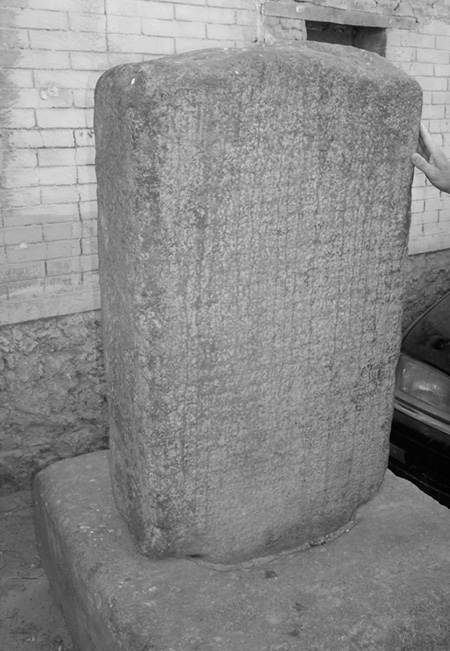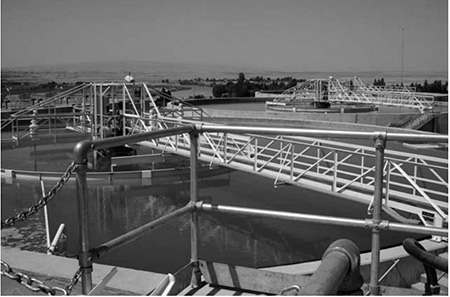Chapter Twenty One
Erbil Citadel
The Regional Government sits in Erbil now and uses the same buildings as the KDP government of 1998/99 and where I had my meetings with the KDP ministers.

The Kurdistan Regional Parliament Building in Erbil with the Council of Ministers Building to its left.
Erbil was mentioned in The Bible and was one of the four great cities of ancient Assur. These were Assur, Nineveh, Nimrud and Arbela (an Aramaic word for present day Erbil). Its name is derived from Araba Ilu meaning the four gods; the Kurds call it Hawler.
It is situated on a plain and the city itself is flat but its centre consists of a large ancient citadel sitting on a tell or mount about 30 metres high. This mount consists of the ancient settlements that were built on top of each other as the city survived through the 8,000 years of its existence. Over the years the mud clay brick buildings used to deteriorate from the time they were built and required constant renewal. In time they crumbled into dust and the following generations built on top of them. This constant renewal is the reason that the Mesopotamian kings were such prolific palace builders as they rebuilt their palaces, frequently putting the new ones in bigger and better locations. Down through the years the citadel has been excavated by archeologists and they are now almost down to the level of the modern city outside. At each consecutive level they found evidence of early settlements.

Aerial Photo of Erbil Citadel in the centre. Note the White Mosque in the centre of the citadel where Farhad al Mulla’s ancestors laboured as clerics and teachers since the 16th century and next to it the dome of the Hammam (Bathhouse).
Photo source: Koosar Nuradeen.
When I expressed an interest in the local archeology, almost immediately Farhad the driver introduced me to a gentleman who he said was the Prime Minister’s Secretary and who often accompanied Farhad and I to one of the beer gardens in Ankawa. This was where the men used to gather of an evening to play chess and dominos and imbibe the fruit of the barley at the tables under the trees.The gentle cooling breeze made for a perfect ambience. Soon I was invited to see the Civilization Museum and met with the curator, Mr Kanan Mufti and local Professors of Archeology who took me on a guided tour. There were many female fertility statuettes and some of the goddess Ishtar on the shelves and many ancient funerary urns lined the floors. They later took me to see a dig in progress in the outskirts of Erbil but asked me not to take photos until they had published their report of the dig in their profession’s journal.
One day Farhad’s friend took me to see the Citadel and on our way in through the main gate we passed the statue of Ibn Al Mistawf. He was a minister in the reign of Mudhafaraddin Kokburi the ruler of Erbil in the Atabakian era and died in 1239 AD. He is noted for writing A History of Arbl. Kokburi was an enlightened associate of Salahadin and established a number of hospitals. Incidentally the second gate of the citadel (there are only two) is named after the grand uncle of Farhad al Mulla pictured in Chapter 19, Ahmed Uthman Effendi.

The Ahmadi Gate named for the grand-uncle of Farhad al Mulla with its relaxed Peshmerga sentry.
Photo source: Kosar Nuradeen.
The Mongols attacked the city unsuccessfully in 1237 AD and returned in 1258 AD when Hulagu’s (grandson of Gengis Khan) Mongol forces captured the citadel after a siege lasting six months. As in Baghdad they massacred the Moslems and set up a Christian Governor. However, the Christians were massacred to a man some years later in 1310AD. Life insurance agents had a lean time in Erbil in this period.
We first went to see the famous bathhouse and its 45-metre deep well. It is situated next to the Citadel Grand Mosque or as some call it the Mulla Effendi Mosque or the White Mosque where Farhad al Mullah’s ancestors preached through the centuries. The Hammam was built in 1775 on typical Islamic bathhouse lines. First one enters the outer hall, the Barrani that was surmounted by a large dome. Then one proceeds into a slightly warm ante room, the Wastani and then into the very hot inner bathroom the Jawani. This also has a large dome with six oculi or glass windows to provide light. The Wastani had six arched alcoves off it to cater for private bathing. The Hamman was open to women until 11 o’clock each morning and to men thereafter.
Some of the houses in the citadel were being restored to act as museums of the citadel and of the area. At the time they had completed a carpet/textile museum and a folklore museum. One of the museums was in the home of our guide Mr Kanan Mufti who was born and reared near the White Mosque. Kanan is one of the famous Mufti brothers of Kurdistan and is currently Director of Antiquities for Kurdistan. His brother Adnan is the Speaker of the Kurdistan Regional Government. In 1964, a floor in his house collapsed during some renovations. Underneath was a whole series of rooms from some previous civilization, possibly the Abbasids, according to Kanan. As far as I know they have yet to be excavated.
As I stated earlier, Erbil is an ancient city. In the Third Millennium BC the city was occupied by the Subarians and the Gutians. It was later raided consecutively by the Akkadians, Sumerians and the Assyrians. I found it distastful that the descendants of these civilizations were treated as an inferior order of humanity by the ‘modern’ world. As Vianne my former secretary wrote to me on 27th February 2003 when the US was debating whether or not to invade Iraq: ‘… Still now we are good but in future we do not know what will happen to us and we hope nothing will happen. You know all of us very afraid. Actually all of us here are afraid of the chemical weapons since my be Sadam will use against the Kurds. Dan our future here is unknown really we do not know what to do? Most of the people in Erbil hired houses in villages because they are planning to go out from Erbil if the war occurs. My family also is thinking to leave Erbil but at the same time Dan is very difficult. The think will kill me we hear from the news every day that US is afraid about his solders or about the Kuwait people or Turkish people but believe me Dan no one is taking care or even think about us, as if we are INSECTS do you believe this? So we have only God now to depend on him and to protect us’.

The Topzawa stele.
Photo source: WC Spiller.
The bilingual Topzawa stele of King Rusas of Urartu is sitting outside the old Citadel Museum. Dating back to the early 9th Century BC it has cuneiform writing in both Assyrian and Urartu languages. Urartu is the language of ancient Armenia. The translation of the text is rather uncertain as it has to be translated from Assyrian and Urartu into Arabic and Kurdish and finally into English.
The reason Erbil survived so long through war and siege is attributed to its reliable water supply provided by artesian wells. These are supplied from deep ancient tunnels called ‘Karez’ (Qanat in Persia) constructed in pre-Islamic times probably in the Christian era. An infiltration tunnel is dug into an aquifer and the water is directed along a tunnel to the point where it is required. The 45-metre deep well in the Citadel Hammam draws its water from them. However, the huge increase of modern inhabitants has led to periodic contamination of the water table from leaking sewer pipes. Cholera is, therefore, a constant threat and was present there during my time in Erbil. The reality of Cholera was, of course, exacerbated by the refusal of the UN Sanctions Committee to allow the free importation of chlorine into Iraq. This was because the chlorine could be used in chemical munitions. Chlorine is required for water purification and without it the contamination went unchecked. Water is necessary everywhere for the support of life but nowhere as important as in places like Kurdistan where the summer temperatures frequently reached 40oC and sometimes 50oC. However, the Karez system seems to have done the job up to the present but with rapidly increasing population it has passed its ‘use by’ date.
We were constantly reminded of the situation by circulars from Krzysztof Ulanowski, the Senior Medical Officer in UNGCI HQ, Erbil. Essentially we were told to avoid raw food with the exception of undamaged fruits and peeled vegetables with the proviso, of course, that they are hygienically handled. Food was to be thoroughly cooked and eaten hot and all cooking utensils were to be cleaned and dried after use. Care was to be exercised in keeping hygienically treated food separate from uncooked food and suspect utensils. Hands were to be washed after using the toilet and before preparing and eating food. We were forbidden to eat food purchased from street vendors and should only drink bottled water or water that has been boiled or chlorinated. (When I worked in Kiev we were advised to boil water for 20 minutes before using it. This was, of course, arising from contaminated water after the Chernobyl accident.) Finally we were to report any stomach upset immediately to the UN doctors.

Water from the Great Zab River makes its way through six clarifying tanks at the Erbil-Ifraz water project.
Photo: LuAnne Fantasia, USACE.
It’s no wonder that the Ifraz Water Project was one of the first major public works undertaken by the Kurdistan Government post-Saddam. The objective of the project was to design and construct a new water supply system to be capable of producing 6,000 cubic metres per hour of potable water, enough for 600,000 people in Erbil. Costing approximately $185 million, the main pumps were officially operated on 22nd March 2007 by Prime Minister, Nechirvan Barzani.